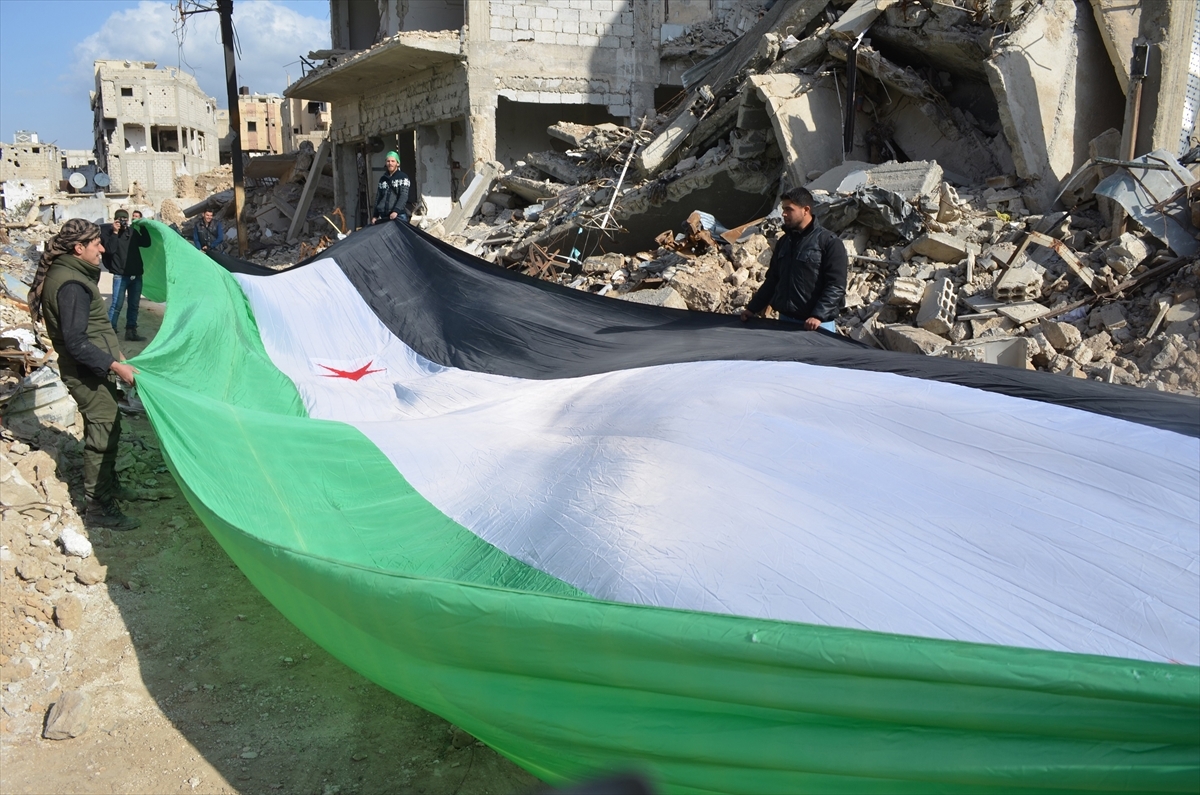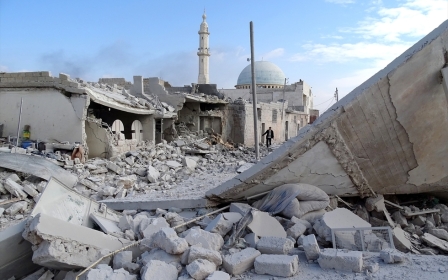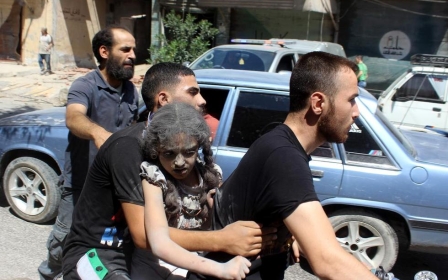BOOK REVIEW: Burning Country

The projector at the Sussex University lecture theatre was showing something out of keeping with the hushed academic environment: besieged Syrian revolutionaries led by former Syrian goalkeeper turned rebel icon Abdel Basset Sarrout leading a chorus to his beloved Homs:
Oh nation of battles, enough tears spilt
Don’t be sad, to heaven go me and my family
I cry and shed tears for the departed
I swear by my God and yours, we will return you
New MEE newsletter: Jerusalem Dispatch
Sign up to get the latest insights and analysis on Israel-Palestine, alongside Turkey Unpacked and other MEE newsletters
Answer them oh revolutionaries and tell them
The Homsies are the heroes, this is their grave.
Unlike the Homsies on the screen behind him, Scottish-Syrian writer Robin Yassin-Kassab was in a despairing mood about the war in Syria. He held out little hope for the US-Russian backed ceasefire, which came into force that same night. Months of Russian bombing had assisted the Syrian army and its Iranian-led Shia militia allies in pushing back rebels around Aleppo and on other fronts.
In front of a packed auditorium, the author and Guardian writer explained how when he lived in Syria prior to the revolution he was not involved in the underground activism that would later emerge as a movement for democratic change. ”I kept my nose clean,” he said.
Burning Country’s co-author Leila al-Shami, a Syrian anarchist blogger, worked with the fearless human rights lawyer Razan Zeitouneh in Damascus, who was abducted in December 2013, possibly by a local warlord, and disappeared. The book is dedicated to her. Zeitouneh was an activist with the Local Coordination Committees of the revolution, whose tireless work in liberated areas constitute for the authors the embodiment of a “miracle” that the world doesn’t see in Syria.
The LCCs took over local services where the government was absent, organised food distribution and education for children in basements even as regime bombs fell. In essence the LCCs and new democratically organised councils were the embryonic form of a new society and politics in the making after decades of dictatorship, even as Assad’s forces sought to crush them.
As well as a non-orthodox telling of the conflict from the point of view of the activists and fighters who took part in the revolution, the book also speaks to the confusion and reluctance of western progressives to engage in the reality of Syria. “What’s happening is of immense human, cultural importance, not just for Syria and the Middle East but for the whole world. We do actually live in age of very messy revolutions,” says Yassin-Kassab.
Western suspicion of Islamists of whatever hue colours how the Syrian revolution is perceived, leading to potentially disastrous conclusions as to how the war might be ended. “There are a huge range of Islamists – we don’t at all agree with them, but nevertheless they are there. Some are foreigners and criminals, some of them are Syrians and represent a constituency,” said Yassin-Kassab.
By late 2013, and certainly by 2015, a consensus had emerged in the West, if not in the Gulf and Turkey, that there were no good opposition forces left on the ground who could take the reigns if and when Assad fell.
The Arab revolutions, because they do not conform to a traditional Marxist or anti-colonial narrative of liberation struggles, and in the case of Syria and Libya are ranged against nominally “anti-imperialist” regimes, have also been misunderstood or even wilfully mischaracterised by western leftists, according to al-Shami and Yassin-Kassab. “I actually fail to see the difference between the left and right as a result of all this. You don’t hear anything about [the Syrian revolutionary movement] in western leftist circles. You need to go to the grassroots to what people are really thinking and feeling.” Without this bottom up approach, the author says that outsiders are “open to the first propagandist narrative that comes along.”
The book does not pretend to be objective in relation to the events in Syria. “We are on the side of the democratic revolution and self-organised groups of activists who are revolutionaries,” says Yassin-Qassab, a regular reviewer for the Guardian and author of Arab diaspora novel The Road to Damascus.
The Assad government and its supporters have always maintained that the opposition is an armed array of terrorists funded by an external conspiracy involving the US, Saudi Arabia, Turkey and Qatar. And of course, it’s true that all those powers want Assad out. Burning Country sets out to prove that the Assad narrative is a false one.
The sectarian and post-colonial nature of Syria, a nation carved out of Bilad al-Sham by Britain and France in 1920, offers clues to the historical mindset that gave rise to the Assad regime. The author points to the creation of an “army of minorities as a divide and rule tactic” by the French colonial authorities following the First World War. It is out of this “sectarian engineering” that the dominant position of the previously impoverished and marginalised Alawis first emerged, leading ultimately to the triumph of Hafez al-Assad, one of the officers who had come up through the ranks of the air force and into post-colonial politics.
The Alawi leadership of which the Assads were part, it should be recalled, feared the departure of the French in the 1940s, since they had given them a new role that they did not want to lose. This fear of the majority Sunnis has been a thread woven into the fabric of the Baathist state that can help us understand what has befallen Syria since 2011.
The book’s early chapters briskly deal with Syria’s history and the rise of the Assads, and the hopes of reform in the early years of Bashar al-Assad’s presidency after 2000. A move away from the state socialism of his father, with its subsidised fuel and food and expanded jobs in the state sector, gave rise to a blatant crony capitalism. While the social support for poor Syrians was reduced, regime insiders grew rich. Assad’s cousin Rami Makhlouf soon “had a finger in 60 percent of the economy,” explained Yassin-Kassab. Makhlouf famously owns Syria’s private telecom network SyriaTel and is said to be worth $5 billion.
“People had been tolerating the situation but security was being removed… Assad personally was popular, the regime wasn’t.” The social contract between the Assads and the population was being stretched to breaking point. Then a street trader in Tunisia set himself on fire, and the fire spread to Egypt, Libya, Yemen and Syria.
Assad’s personal popularity led to hopes early on in the protests that the president would respond by reforming the system and might even come out in support of the demands for change. In a much-awaited speech on 30 March, a giggling Assad dashed all such illusions, describing the protests as a conspiracy aimed at the whole of Syria, while his supporters chanted his name.
The book plunges into the early heady days of the protest movement. For the first time, thousands threw off their fear and found their voice in the Assads’ “kingdom of silence”. Once released, the energy of the newly mobilised youth, not connected to the traditional political parties who were mostly co-opted or exiled abroad, could not be put back in the box.
“Freedom is like a magnet, it attracts the people who have been silenced for too long,” explains an eyewitness to mass protest in Homs. “The chance is now available to…scream in the face of the suppressor, to prove all these identities that have been concealed by an iron fist.”
Four years on it is easily forgotten what the many personal testimonies included in Burning Country make abundantly clear: in the early days, before the regime’s sectarian narrative and terror tactics took hold, a united, non-sectarian movement for peaceful change was unleashed in 2011. It was this movement that the government feared more than any militia or terrorist group.
Through testimonies, we enter the agonising phase of protestors being gunned down, the first of the Shabiha massacres, bodies of children returned to families mutilated, and the inevitability of an armed insurrection, which many of the non-violent activists felt strongly even then would fail. Yassin-Kassab refutes the idea that those who took up arms had a “choice” – the brute violence of the repression denied any. The only choice was to fight or flee.
However, activists knew that once the initiative was in the hands of armed militias, the initial spirit of democratic and non-sectarian revolution would be eclipsed by Islamist ideology, backed by regional powers. And so it came to pass.
As massacres of all sects occurred in 2012, minorities, Alawis and Christians, clung to the regime. “Why have the majority of Alawis stuck with Assad? Alawis are human beings like anyone else. Apart from one or two psychopaths who enjoy inflicting violence, they are scared,” said the author, and through a series of manipulated sectarian massacres, “they are implicated in the regime’s crimes” and fear being slaughtered.
And yet, and yet. The authors are vehemently opposed to the idea, popular in the West, that there are no Syrians left with a legitimate say in the future of their country. That the war is simply a geopolitical proxy conflict involving the various powers and regional forces allied to local ethnic and Islamist militias.
They refute the mainstream Western view on left and right that its either Assad or Al-Nusra / ISIS and we must take sides. That the man in the suit, despite having the blood of countless of his fellow Syrians on his hands, is the best and only option.
Perhaps one of the most damning indictments in the book is of President Obama’s cynical, so-called “realist” Syria policy, which supported the Free Syrian Army but only with enough weaponry to keep the fighting going, without ever threatening to shift the balance decisively either way. As soon as the rebels made advances the weapons would dry up, they write. When Assad’s forces advanced, new weapons became available. This drift in the war seemed to suit Washington, even as Syria was turned to rubble. From Bush’s shock and awe in Iraq, we arrive at Obama’s stop and start war in Syria, with its focus on IS while ignoring the regime’s role in creating the conditions for the extremist militants to flourish.
The US wanted to remove the figurehead while preserving the regime, and in so doing avoid the disaster of Iraq caused by Bush defence secretary Donald Rumsfeld’s dismantling of the state. And yet in rejecting the Bush doctrine, and pushing its weapon-starved "moderate" allies into the hands of Nusra and Ahrar al-Sham, the Obama doctrine still helped bring forth the nightmare scenario. Enter ISIS via Iraq.
No one of course can pretend that the West had any easy options. Calls from activists and the Saudis for the rebels to be provided anti-aircraft weapons make sense when you are under barrel bombs, until you recall what happened to US hardware in Iraq in 2014, and imagine such missiles being aimed at civilian aircraft by ISIS (strong evidence suggesting just that happened in 1996 when a US ground-to-air missile given to al-Qaeda-linked Bosnian fighters probably brought down TWA800 over New York).
In its conclusion, the authors despair at the bipolar Cold War era view of the world in which the Assad regime is part of the camp resisting US hegemony along with its allies Russia and Iran. “By this reading, the Syrian state (rather than the Syrian people) is the underdog.”
They point to the resistance narrative used by the regime – with military bases outside of every town allegedly to defend them against Israeli aggression until their true function was revealed during the counter-revolutionary war. Set against its welcoming of the Palestinians and support for Hezbollah in its battles with Israel is the regime’s alliance with right-wing Christian forces during Lebanon’s civil war and the massacre of Palestinians at Tel Zaatar in 1976, as well as its cooperation with the West during the war on terror.
The authors hold on to optimism that, despite the setbacks and horrors, the exiled activists still have the stomach to resume their democratic revolution. “There’s reason to hope that when the bombs finally stop falling, when ISIS and regime checkpoints no longer threaten death, these people will return and raise their voices again for a better future.”
One can only hope they are right.
Burning Country: Syrians in Revolution and War by Robin Yassin-Kassab and Leila al-Shami (Pluto Press 2016)
Middle East Eye delivers independent and unrivalled coverage and analysis of the Middle East, North Africa and beyond. To learn more about republishing this content and the associated fees, please fill out this form. More about MEE can be found here.




